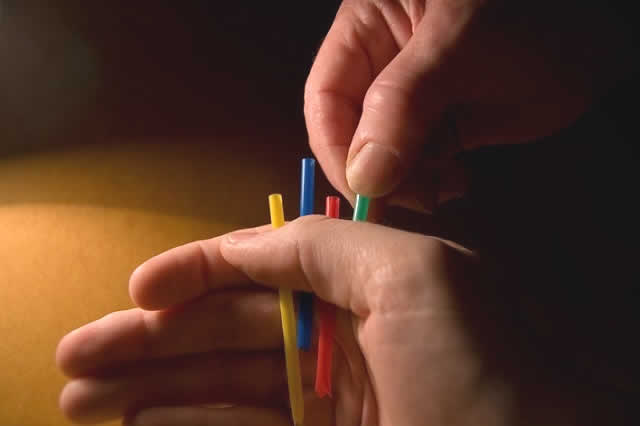Inglês Online
O que significa “the short end of the stick” em inglês?

Levar a pior em inglês: To get (or hold) the short end of the stick
“To get (or hold) the short end of the stick” significa levar a pior em inglês. Ou seja, ser o mais prejudicado ou desfavorecido num acordo ou decisão. Ficar com a pior parte dum negócio, divisão ou acordo. Fazer um mau negócio ou ficar em desvantagem numa situação. Ficar com a parte menos agradável de qualquer coisa.
What does “to get (or hold) the short end of the stick” mean?
“To get (or hold) the short end of the stick” is an idiom. The definition or meaning is “to suffer the bad effects of a situation; to be slighted in some way”. Another meaning would be “to be in a worse position than other people in a particular situation, although this is not one’s fault; to be in a difficult or unpleasant part of a task or situation”. See some examples with Portuguese translation.
How do you say “to get (or hold) the short end of the stick” in Portuguese?
- She got the short end of the stick when she was assigned another week of night duty. / Sobrou pra ela a responsabilidade de ficar no plantão da noite mais uma semana.
- When you jerks drop the ball, I’m left holding the short end of the stick. / Quando vocês babacas pisam na bola, sou eu quem assume a bronca sozinho.
- When I work with him, I always get the short end of the stick. / Quando eu trabalho com ele, eu sempre fico a pior parte do serviço.
- The building is being renovated, but for the moment people living there get the short end of the stick. / O prédio está sendo reformado, porém, no momento, quem mora lá é quem está pagando o pato.
- He certainly got the short end of the stick on that negotiation. / Ele com certeza levou a pior nessa negociação.
- Women get the short end of the stick in relationships with famous guys. / A mulheres levam a pior em relacionamentos com caras famosos.
Inglês Online
DIVIDIR/RACHAR A CONTA: Como se diz em inglês?

To go Dutch | To go halves | To go fifty-fifty
“To go Dutch, to go halves, to go fifty-fifty” significam rachar a conta em inglês. Ou seja, rachar ou dividir a conta meio a meio. Dividir a despesa em partes iguais entre duas pessoas, como por exemplo a conta do restaurante.
What does “to go Dutch, to go halves” mean?
“To go Dutch , to go halves” are phrasal verbs. The definition or meaning is “to share the cost of something equally between two people”. Another meaning would be “to share the cost, each pay half the cost (especially of a date) “.
How do you say “to go Dutch, to go halves” in Portuguese?
- We each has about the same amount to eat and drink, so let’s go halves on the bill. / Cada um de nós tem em torno da mesma quantia pra comer e beber, então vamos rachar a conta.
- I’m pretty broke, but I’ll go halves with you on a bottle of wine. / Estou na pindaíba, mas vou dividir a conta com você na garrafa de vinho.
- Ann suggested that they go halves on the rent. / A Ana sugeriu que eles rachassem o aluguel.
- Shall we go halves on a present for Ann? / Vamos rachar o presente da Ana?
- Would you like to go halves in the grocery bill? / Gostaria de rachar comigo a conta da mercearia?
- Is it still considered a date if you go Dutch? / Será que ainda é um encontro se você rachar a conta?
- ‘Will you let me take you out tonight?’ ‘As long as we go Dutch.’ / ‘Você vai me deixar te levar pra sair essa noite?’ ‘Desde que nós rachemos a conta’.
- The brothers are going fifty-fifty in their new business. / Os irmão vão entrar meio a meio no novo negócio.
Qual é a diferença entre “go halves“, “go Dutch“, “go fifty-fifty” em inglês?
“Half” significa metade ou meio em inglês. Portanto, “go halves” é o plural de “go half“, sendo que “go halves” é a expressão mais comum. Enquanto “go half” não soa bem, já “go halves” ou “go half-and-half” soa normal. Nos E.U.A., quando se trata de crianças dividindo alguma coisa é comum o uso informal do termo “halvesies” (hav-zeez). Agora, no caso de um encontro, em que cada um paga a sua parte da conta, então o termo usado é “to go Dutch“.
Há também o termo “half and half” ou “50-50“, embora seja usado principalmente para descrever combinações de diferentes tipos ou sabores de comida.
- Do you want white meat (chicken), dark meat, or half and half? / Você quer carne branca (frango), carne vermelha ou meio a meio?
- “Do you take cream or milk with your tea?” “I use half and half“. / “Você toma o seu chá com leite (ou creme)?” “Eu tomo meio a meio”.
Inglês Online
Como se diz “solução” em inglês?

Solução em inglês: Solution
“Solution” significa solução em inglês. Ato ou efeito de solver; solvência. Resolução de qualquer dificuldade, questão etc. Meio de superar ou resolver uma dificuldade, um problema. Ação de um líquido sobre um sólido, cujo resultado definido é tomar este último também a forma líquida; dissolução. Resultado de uma dissolução. Líquido que contém uma substância em dissolução.
What does “solution” mean?
“Solution” is an noun. The definition or meaning is “the act or process of solving a problem or question; explanation, an answer to a problem”. Another meaning would be “mixture made up of one substance that has dissolved into another; dissolving of one substance into another”. See some examples with Portuguese translation.
How do you say “solution” in Portuguese?
- There’s no easy solution to the problem. / Não há solução fácil para o problema.
- How do you do a solution of ammonia in water? / Como você faz a solução de amônia em água?
- This business is pendent. | This is pending matter. / Este negócio está aguardando solução.
- They are meeting to find the resolution of a problem. / Eles estão em reunião para encontrar a solução de um problema.
- I don’t think this is the best solution. / Eu não acho que essa seja a solução ideal.
O que significa “band-aid solution” em inglês?
“Band-aid solution” é uma solução temporária, um quebra-galho, a solução improvisada de um problema.
O que significa “the Final Solution” em inglês?
“The Final Solution” significa a solução final. A solução final era o plano nazista para exterminação do povo judeu durante a Segunda Guerra Mundial.
- My great-grandfather was one of only a few Jews in his city to survive the Final Solution in Germany during World War II. / Meu tataravô foi um dos únicos poucos judeus em sua cidade que sobreviveu à solução Final da Alemanha na Segunda Guerra Mundial.
O que significa “Procrustean solution” em inglês?
“Procrustean solution” significa leito de Procusto. Segundo a mitologia grega, Procusto (nome que significa esticador), era um famigerado salteador que morava numa casa a beira da estrada e, com o pretexto de oferecer refeições e pernoite aos viajantes, convidava-os à sua casa. Ele tinha um leito (cama) de ferro onde, estendia aqueles que capturava, cortando-lhes os pés quando o ultrapassavam e estirando-os quando não lhe alcançavam o tamanho. Essa prática só teve fim quando o herói Teseu (o mesmo que matou o Minitauro) fez Procusto experimentar do seu próprio veneno.
Então, por extensão, passou a significar uma situação independente da vontade do indivíduo em que este peca e sofre as consequências, quer por excesso, quer for falta. Manipular os fatos para ajeitar uma situação. Alguém que altera os fatos por, por exemplo, superestimar ou omitir informações, pode-se dizer está oferecendo um Leito de Procusto.
Veja os posts:
Como dizer “problema” em inglês?
Como se diz “quebra-galho” em inglês?
Como se diz “amigo-da-onça” em inglês?
Como se diz “matar dois coelhos com uma só cajadada” em inglês?
[consultanome]
Inglês Online
O que é “pronome demonstrativo” em inglês?

Pronome demonstrativo
“Demonstrative pronouns” são pronomes demonstrativos em inglês. Os pronome demonstrativo tem a função de indicar algo. As palavras “this, that, these and those” são pronomes demonstrativos em inglês.
What does “demonstrative pronouns” mean?
“Demonstrative pronouns” are pronouns obviously. The definition or meaning is “pronouns that point out objects”. Another meaning would be “pronouns that are used to point out things”.
How do you say “demonstrative pronouns” in Portuguese?
- Whose cat is this? / De quem é esse gato?
- That is my pet. / Aquele é o meu bicho de estimação.
- These are cats but those are dogs. / Esses são gatos mas aqueles são cachorros.
- And those are kittens. / E aqueles são gatinhos.
Os pronomes demonstrativos são: THIS, THAT, THESE, THOSE.
|
||||||||||||
|
|
||||||||||||
|
Veja o post: |
||||||||||||
[consultanome]












